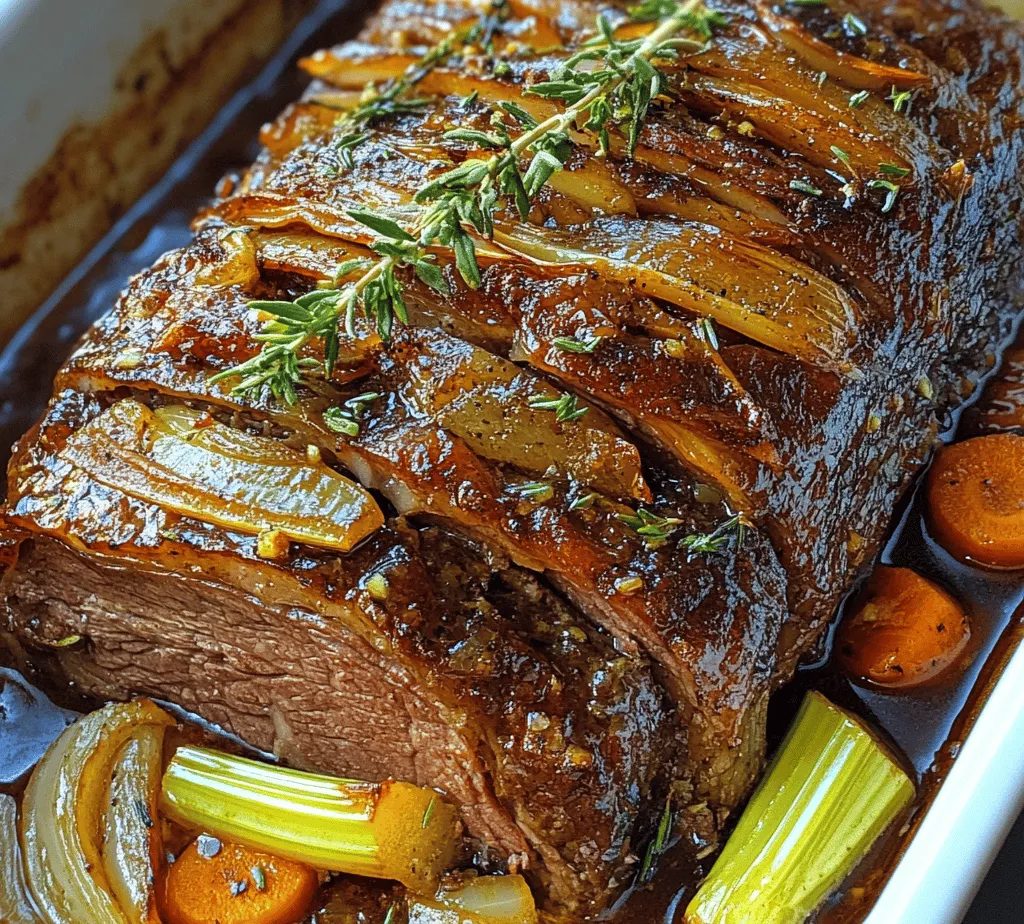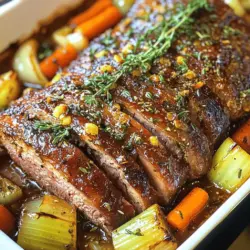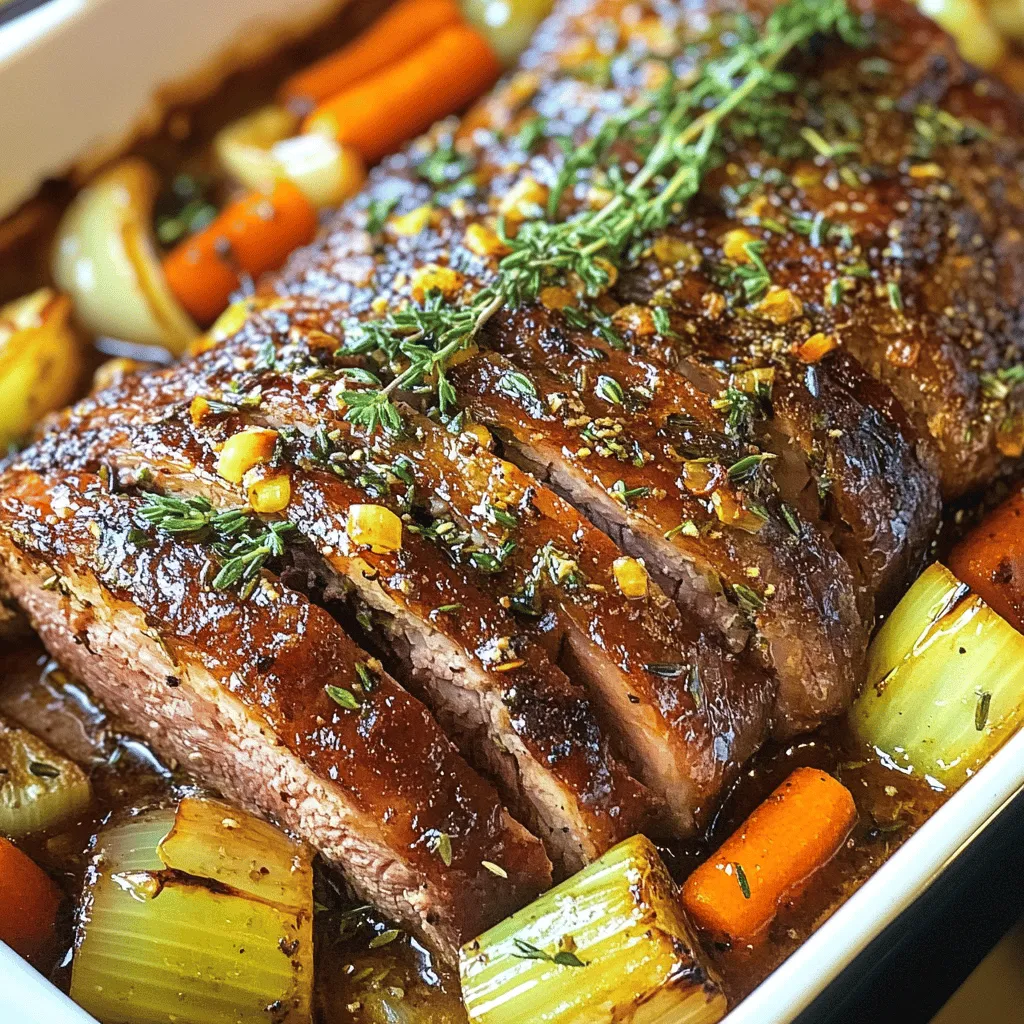Introduction
Brisket has long been celebrated as one of the most flavorful and beloved cuts of beef, known for its rich taste and tender texture when prepared correctly. This cut, originating from the chest of the cow, is a staple in various culinary traditions around the world. The popularity of brisket can be attributed to its versatility and ability to absorb flavors beautifully, making it an ideal choice for slow cooking—an essential technique for enhancing both flavor and tenderness.
Slow cooking is the secret to achieving that melt-in-your-mouth quality that brisket aficionados crave. By cooking the brisket at low temperatures over an extended period, the connective tissues break down, resulting in a succulent and juicy piece of meat. This cooking method allows the brisket to soak in the flavors of accompanying herbs and spices, creating a dish that is not only satisfying but also a feast for the senses.
Today, we’re diving into a culinary delight that showcases brisket at its best: Savory Oven Roasted Brisket with Herb Crust. This mouthwatering dish is perfect for gatherings and festive occasions, serving as a centerpiece that will impress your guests and leave them asking for seconds. The herb crust adds a fragrant layer of flavor that complements the richness of the brisket, while the slow roasting process ensures that every bite is tender and juicy.
Understanding Brisket
Before we delve into the specifics of this recipe, it’s important to understand what brisket is and what makes it unique. Brisket is a cut of meat from the breast or lower chest of a cow. It is characterized by its rich flavor, thanks to its marbling of fat, which melts during the cooking process and infuses the meat with moisture and taste. There are two main types of brisket cuts: the flat cut and the point cut.
Flat Cut vs. Point Cut Brisket
The flat cut, also known as the first cut or the lean cut, is the more commonly used part of the brisket. It is known for its uniform thickness and is often leaner than the point cut. This cut is ideal for slicing and is often used for dishes like pastrami or corned beef.
On the other hand, the point cut, sometimes referred to as the deckle, is thicker and has more marbling, which gives it a richer flavor and makes it more tender. The point cut tends to be fattier than the flat cut, making it perfect for shredding and using in recipes like brisket tacos or sandwiches.
For our Savory Oven Roasted Brisket with Herb Crust, either cut can be used, but it is recommended to choose a brisket with a good amount of marbling to ensure a moist and flavorful final dish.
Ideal Cooking Methods for Brisket
While brisket can be prepared in various ways, slow roasting is the most effective method to achieve the desired tenderness and flavor. Slow roasting allows the meat to cook evenly and gives the spices and herbs time to permeate the brisket. Other popular cooking methods include smoking, braising, and pressure cooking, but none quite compare to the traditional oven roasting process when it comes to flavor and texture.
When roasting brisket in the oven, it’s essential to maintain a low and steady temperature, usually around 225°F to 275°F. This ensures a gradual cooking process that breaks down the tough fibers while retaining moisture.
Health Benefits of the Ingredients
Understanding the health benefits of the ingredients used in our Savory Oven Roasted Brisket can enhance your appreciation for this delicious dish.
Nutritional Profile of Beef Brisket
Beef brisket is not only a flavorful cut of meat but also packs a nutritional punch. It is rich in protein, which is essential for muscle growth and repair, making it an excellent choice for anyone looking to maintain a healthy diet. Additionally, brisket provides important vitamins and minerals, including iron, zinc, and B vitamins, which are crucial for energy metabolism and overall health.
While brisket is higher in fat compared to leaner cuts of beef, the fat content can be beneficial when consumed in moderation, as it provides a source of energy and supports the absorption of fat-soluble vitamins.
Benefits of Fresh Herbs
The herb crust in our recipe features fresh rosemary and thyme, both of which are not only flavorful but also offer numerous health benefits. Rosemary is known for its antioxidant properties, which can help combat oxidative stress in the body. It is also believed to support digestion and enhance memory and concentration.
Thyme, on the other hand, is rich in vitamins A and C, as well as iron and manganese. It has antimicrobial properties and can support respiratory health. The combination of these herbs not only elevates the flavor of the brisket but also contributes to the overall healthfulness of the dish.
Importance of Vegetables
In addition to the brisket and herbs, this recipe includes a medley of vegetables such as onions, carrots, and celery. These vegetables not only add flavor and texture but also bring a wealth of nutrients to the dish. Onions are rich in antioxidants and can support heart health, while carrots provide beta-carotene and fiber. Celery is low in calories and high in vitamins K and C, making it a great addition to boost the nutritional profile of the meal.
Role of Broth
Broth plays a key role in enhancing the moisture and flavor of the brisket. Using high-quality beef broth not only helps to keep the meat juicy as it cooks but also infuses the brisket with additional depth of flavor. Homemade broth can be made using leftover bones and vegetables for an even more nutritious option, or you can opt for low-sodium store-bought versions if time is of the essence.
Ingredients Breakdown
Now that we’ve established a solid understanding of brisket and its benefits, let’s break down the ingredients used in our Savory Oven Roasted Brisket with Herb Crust. Each ingredient plays a vital role in creating a flavorful and satisfying dish.
1. Brisket
The star of the show is, of course, the brisket. When selecting your brisket, look for a cut that has a good amount of marbling, as this will ensure a juicy and flavorful result. If possible, opt for grass-fed beef, as it is often more flavorful and nutritious compared to grain-fed counterparts.
2. Fresh Herbs (Rosemary and Thyme)
Using fresh herbs instead of dried will significantly enhance the flavor of the herb crust. When shopping for herbs, look for vibrant, fragrant sprigs without any wilting or browning. If fresh herbs aren’t available, you can use dried herbs, but keep in mind that the flavor will be more concentrated, so you may need to adjust the quantities accordingly.
3. Vegetables (Onions, Carrots, Celery)
The aromatics—onions, carrots, and celery—create a flavorful base for the brisket. When preparing your vegetables, choose organic options if available, as they are free from harmful pesticides and chemicals.
4. Beef Broth
For the broth, choose a high-quality beef broth or stock, preferably low-sodium to control the salt content in your dish. If you have homemade broth on hand, this is an excellent time to use it. The broth will help keep the brisket moist and infuse it with deep flavor.
5. Seasonings
In addition to the herbs, you will need basic seasonings such as salt and pepper. These ingredients may seem simple, but they are essential for enhancing the natural flavors of the brisket and the vegetables.
6. Optional Ingredients
You can also consider adding a splash of red wine or Worcestershire sauce to the broth for added complexity and depth of flavor. These ingredients can enhance the savory notes of the dish and complement the richness of the brisket beautifully.
Step-by-Step Cooking Instructions
Now that we have a clear understanding of the ingredients and their benefits, let’s move on to the step-by-step instructions for preparing the Savory Oven Roasted Brisket with Herb Crust.
Preheating the Oven
The first step in preparing your brisket is to preheat your oven. Set it to a low temperature of around 225°F (107°C) to 275°F (135°C). This slow and steady heat will ensure that the brisket cooks evenly and slowly, yielding the best texture and flavor.
Preparing the Brisket
Once the oven is preheated, it’s time to prepare the brisket. Start by patting the brisket dry with paper towels. This step is crucial for achieving a nice crust during the cooking process. After drying, generously season the brisket on all sides with salt and pepper.
Next, create the herb crust by finely chopping the fresh rosemary and thyme. In a small bowl, combine the chopped herbs with a bit of olive oil to create a paste. Rub this mixture all over the brisket, ensuring that it is evenly coated.
Searing the Brisket
For an added layer of flavor, sear the brisket before placing it in the oven. Heat a large skillet or Dutch oven over medium-high heat and add a splash of oil. Once the oil is hot, carefully place the brisket in the pan, fat side down. Sear for about 4-5 minutes until a golden-brown crust forms. Flip the brisket and sear the other side for an additional 4-5 minutes.
This process, known as the Maillard reaction, enhances the flavor of the meat by creating a beautiful brown crust. The caramelization of the natural sugars in the meat is what gives it that rich, savory flavor that we all love.
Preparing the Vegetables and Broth
While the brisket is searing, prepare the vegetables. Chop the onions, carrots, and celery into large chunks. Once the brisket is seared on both sides, remove it from the skillet and set it aside. In the same skillet, add the chopped vegetables and sauté them for a few minutes until they begin to soften and caramelize.
After the vegetables have cooked down a bit, deglaze the pan with a splash of beef broth, scraping up any browned bits that may have stuck to the bottom. This step will add even more flavor to your dish.
Now, place the seared brisket back into the skillet with the sautéed vegetables. Pour the remaining beef broth over the brisket, ensuring that it is well-covered but not submerged.
With the brisket and vegetables ready, you are now prepared to transfer everything to the preheated oven.
Roasting the Brisket
Cover the skillet or Dutch oven with a lid or aluminum foil and place it in the oven. Allow the brisket to roast slowly for about 3 to 4 hours, or until it is fork-tender. The exact cooking time will depend on the size of your brisket, so it’s essential to check for doneness periodically.
As the brisket roasts, the aromas of the herbs and vegetables will fill your kitchen, tantalizing everyone nearby and building anticipation for the delicious meal that awaits.
By following these steps, you are well on your way to creating a delectable Savory Oven Roasted Brisket with Herb Crust that will be the highlight of any gathering.
Stay tuned for the next part of this article, where we will explore additional tips for achieving the perfect brisket and answer some common questions related to this beloved dish.

Cooking the Vegetables
To complement the rich flavors of the Savory Oven Roasted Brisket with Herb Crust, the sautéed vegetables play a crucial role. Start by selecting your favorite vegetables, such as carrots, onions, celery, and bell peppers. Cut them into uniform pieces to ensure even cooking.
In a large skillet, heat a tablespoon of olive oil over medium heat. Once the oil is hot, add the chopped onions and sauté until they become translucent, which should take about 3-4 minutes. Next, add the carrots and celery, cooking them for an additional 5-7 minutes until they soften slightly. The goal here is to develop the natural sweetness and depth of flavor in the vegetables, which will enhance the overall dish.
If you wish to add a bit of color and flavor, consider including bell peppers or even mushrooms. Sauté these for a few minutes until they are just tender. Season the vegetables with a pinch of salt and freshly cracked black pepper to elevate their taste. Once they are sautéed to perfection, remove them from the heat and set them aside until you’re ready to incorporate them into the brisket dish.
Deglazing the Pan
After sautéing the vegetables, it’s essential to deglaze the pan to extract all those delicious browned bits stuck to the bottom. These bits, known as fond, contain concentrated flavors that will enhance the overall taste of your brisket.
Pour in a half-cup of red wine or broth into the hot skillet, scraping the bottom with a wooden spoon to release the fond. Allow the liquid to simmer for a couple of minutes, letting it reduce slightly. This process not only adds depth to the flavor profile but also enhances the sauce that will accompany the brisket. After deglazing, pour the mixture over the brisket in the roasting pan.
Adding the Broth
To create a flavorful cooking base, add the broth to the brisket. You can use beef broth for a richer flavor or chicken broth for a lighter option. Pour in about 1 to 1.5 cups of broth into the roasting pan, ensuring that it surrounds the brisket but does not submerge it completely.
This broth will not only keep the meat moist during cooking but will also be essential in forming a delicious gravy or sauce later on. The combination of the sautéed vegetables, deglazed liquid, and broth will create a harmonious base that elevates the brisket’s flavors as it roasts.
Covering and Roasting
Once all the components are in place, it’s time to cover the brisket and place it in the oven. Cover the roasting pan tightly with aluminum foil or a lid, which is crucial for moisture retention. This step ensures that steam circulates within the pan, allowing the brisket to cook evenly and preventing it from drying out.
Preheat your oven to 300°F (150°C) and roast the brisket for about 3-4 hours, depending on the size of the cut. A general rule of thumb is to allow for 1 hour of cooking time per pound of meat. The low and slow cooking method breaks down the connective tissues in the brisket, resulting in a tender and juicy dish.
Resting the Brisket
After the brisket has finished roasting, remove it from the oven and let it rest for at least 30 minutes before slicing. This resting period is critical as it allows the juices to redistribute throughout the meat, ensuring that each slice remains moist and flavorful. Cover the brisket loosely with foil to keep it warm while it rests.
Slicing Techniques
When it’s time to serve, slicing the brisket correctly is vital for texture and presentation. Always slice against the grain. This means cutting across the muscle fibers, which results in more tender bites.
To identify the grain direction, look at the meat closely; you’ll see the lines running in one direction. Use a sharp carving knife for clean cuts. Aim for slices that are about 1/4 to 1/2 inch thick. Arrange the slices on a platter, fanning them out for an appealing presentation.
Cooking Tips for Perfect Brisket
– Best Practices for Tender Brisket: Always choose a well-marbled brisket, as the fat will render during cooking, keeping the meat moist and flavorful. Consider brining or marinating the brisket ahead of time for added flavor and tenderness.
– Cooking Time and Temperature Control: Maintain a steady cooking temperature to avoid drying out the meat. Using a meat thermometer can help you monitor the internal temperature, aiming for about 190-205°F (88-96°C) for optimal tenderness.
– Adjusting Seasoning: As the brisket cooks, taste the broth and adjust seasoning as necessary. If you prefer a more robust flavor, consider adding more herbs or spices during the cooking process.
– Checking Doneness: A fork test is an excellent way to check the brisket’s doneness. If you can easily pull the meat apart with a fork, it’s ready. Alternatively, use a meat thermometer for precision.
Serving Suggestions
When it comes to serving your Savory Oven Roasted Brisket with Herb Crust, presentation is key. Arrange the sliced brisket on a large serving platter, garnishing with fresh herbs like parsley or thyme for a pop of color. Surround the brisket with sautéed vegetables and a drizzle of the pan juices for a complete aesthetic.
Pairing Suggestions: Complement your brisket with classic sides such as creamy mashed potatoes, coleslaw, or roasted vegetables. The richness of the brisket pairs beautifully with the creaminess of the potatoes, while the crunch of coleslaw adds a refreshing contrast.
Sauces and Condiments: Consider serving your brisket with a homemade gravy made from the pan drippings, or a tangy barbecue sauce for a different flavor profile. Horseradish sauce can also provide a delightful kick that balances the savory meat.
Storing and Reheating Leftovers
If you find yourself with leftover brisket, proper storage is essential to maintain its quality. Allow the brisket to cool completely before wrapping it tightly in plastic wrap or aluminum foil, or place it in an airtight container. Store it in the refrigerator for up to 3-4 days or freeze it for longer storage, up to 3 months.
Reheating Tips: When reheating brisket, aim to restore its tenderness and moisture. Preheat your oven to 325°F (160°C), place the brisket in a baking dish, and add a splash of broth or water to maintain moisture. Cover with foil and heat for about 20-30 minutes, or until warmed through.
Creative Ways to Use Leftovers: Leftover brisket can be transformed into a variety of dishes. Consider making brisket sandwiches with crusty bread and a smear of mustard, or tacos topped with fresh salsa and avocado. You can also add brisket to a hearty soup or stew, enhancing the flavor and adding protein.
Conclusion
Making and sharing Savory Oven Roasted Brisket with Herb Crust is a labor of love that rewards you with rich flavors and tender meat. This dish is not just a meal; it’s an experience that brings people together around the table, creating lasting memories.
As you embark on this culinary journey, feel free to experiment with variations and personal touches. Whether it’s adjusting the herbs, trying different vegetables, or pairing it with unique sides, the possibilities are endless. Enjoy the process and the joy that comes from sharing this delicious brisket with family and friends. Happy cooking!



